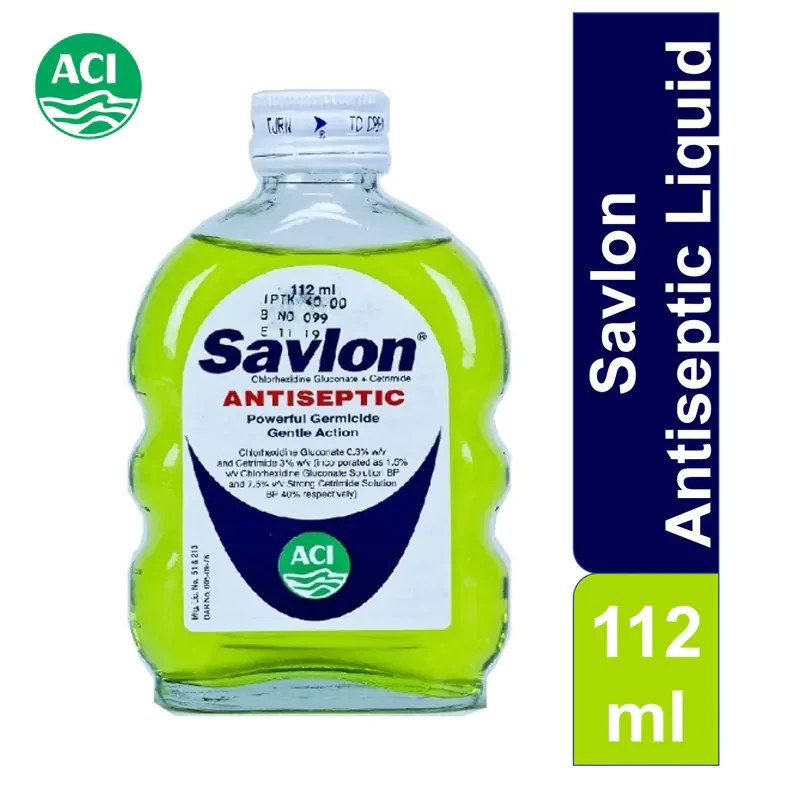Savlon Uses, Dosage, Side Effects and more
Cetrimide is a quaternary ammonium antiseptic; it has bactericidal activity against both gram-positive and gram-negative organisms.
Chlorhexidine is an antimicrobial agent; it is active against a wide range of gram-negative and grampositive vegetative bacteria, yeasts, dermatophyte fungi and lipophilic viruses.

| Attribute | Details |
|---|---|
| Trade Name | Savlon |
| Generic | Chlorhexidine + Cetrimide |
| Weight | 0.3% + 3%, 0.1% + 0.5% |
| Type | Solution, Cream |
| Therapeutic Class | Chlorhexidine & Chloroxylenol preparations |
| Manufacturer | ACI Limited |
| Available Country | Bangladesh |
| Last Updated: | January 7, 2025 at 1:49 am |
Uses
Cetrimide & Chlorhexidine Gluconate is used for disinfection, cleansing and irrigating the skin or dirty wounds
Savlon is also used to associated treatment for these conditions: Catarrh of the throat, Chemotherapy Induced Mucositis, Chronic Wounds, Decubitus Ulcer, Dental Cavity, Dysphagia, Eczema infected, Foeter Ex Ore, Gingival Bleeding, Gingival disorders NEC, Gingivitis, Glossitis, Hoarseness, Infection, Infectious Periodontal Diseases, Injury Throat, Mild to Moderate Inflammatory Reaction of the Oral Cavity, Mild to Moderate Inflammatory Reaction of the Pharynx, Mouth injury, Mucositis, Neurodermatitis, Ocular Inflammation, Ocular Irritation, Oral Aphthous Ulcer, Oral Infection, Pain, Periodontitis, Pharyngitis, Plaque, Dental, Postoperative Wound Infection, Purulent Gingivitis, Radiation Mucositis, Red eye, Ringworm, Skin Infections, Skin Infections, Bacterial, Sore Throat, Stomatitis, Surgical Wound, Tissue Damage, Tonsillitis, Ulcer, Aphthous, Ulcers, Leg, Wound Infections, Dry, cracked skin, Gum disorder, Gum pain, Moderate Gingivitis, Oral lesions, Recurrent Oral fungal infection, Severe Gingivitis, Superficial Wounds, Throat disinfection, Tongue inflammation, Anesthesia of Mucous Membrane, Antimicrobial Therapy, Contact Lens Care, Disinfection, Disinfection of External Genitalia, Disinfection of the Urethra, Disinfection of the Vaginal Mucosa, Irrigation therapy, Lubrication of the Urethra, Oral Care, Oral Hygiene, Oropharyngeal antisepsis, Skin disinfection, Surgical Scrubbing, Topical Antisepsis, Urethral Anesthesia, Wound Cleansing, Wound Healing, Oral antisepsis, Oral disinfection
How Savlon works
Chlorhexidine’s broad-spectrum antimicrobial effects are due to its ability to disrupt microbial cell membranes. The positively charged chlorhexidine molecule reacts with negatively charged phosphate groups on microbial cell surfaces - this reaction both destroys the integrity of the cell, allowing leakage of intracellular material, and allows chlorhexidine to enter the cell, causing precipitation of cytoplasmic components and ultimately cell death. The specific means of cell death is dependent on the concentration of chlorhexidine - lower concentrations are bacteriostatic and result in leakage of intracellular substances such as potassium and phosphorous, whereas higher concentrations are bactericidal and cause cytoplasmic precipitation.
Dosage
Adult: Topical per ml of liquid contains cetrimide 30 mg and chlorhexidine 3 mg: Use as directed.
How Long Does It Take to Work?
How Long Does It Take to Work? see here Savlon
Side Effects
Repeated application may lead to skin irritation.
Toxicity
The LD50 of subcutaneously administered chlorhexidine in mice is >5 g/kg.
Small children are likely to be more susceptible to chlorhexidine overdose - ingestion of 1-2 ounces by a small child may result in gastric distress, nausea, and intoxication. Treatment should consist of symptomatic and supportive measures. Seek medical attention if a child ingests >4 ounces of chlorhexidine solution or if symptoms of intoxication develop post-exposure.
Precaution
• Keep away from the reach of children
• If the solution comes in contact with eyes, wash your eyes with water immediately ·
• 3. Keep away from light and keep at room temperature• Keep away from combustible material and fire
Interaction
There are no known drug interactions and none well documented.
Elimination Route
Topically, chlorhexidine is unlikely to undergo any degree of systemic absorption. Orally administered chlorhexidine, such as that found in oral rinses for dental purposes, is very poorly absorbed from the gastrointestinal tract - the Cmax in human subjects following an oral dose of 300mg was 0.206 µg/g and occurred approximately 30 minutes after ingestion (Tmax). Following the insertion of 4 PerioChips in 18 adult patients, no detectable plasma or urine chlorhexidine levels were observed.
Elimination Route
Excretion of chlorhexidine gluconate occurs almost exclusively via the feces, with less than 1% of an ingested dose excreted in the urine.
Pregnancy & Breastfeeding use
Pregnancy Category-Not Classified. FDA has not yet classified the drug into a specified pregnancy category.
Contraindication
Not to be used in the eye, ear, mucous membrane or body cavities.
Storage Condition
Store below 25° C.



